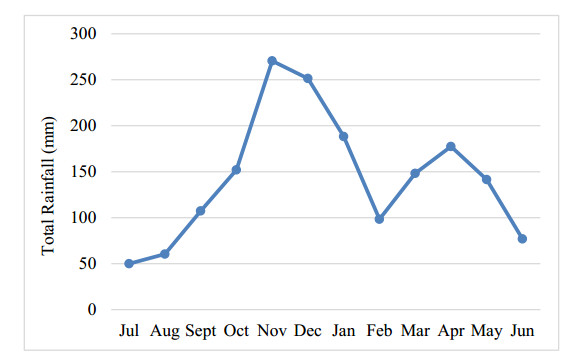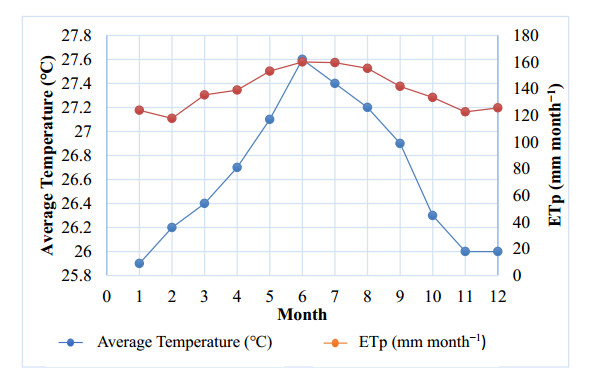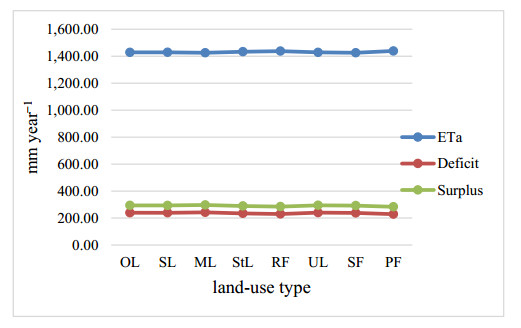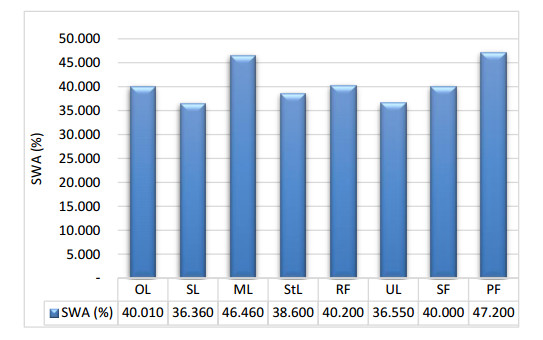The increasing intensity of land conversion in the Krueng Jreu sub-watershed from forest to non-forest or land-use changes causes changes in land biophysical characteristics. Changes in land biophysical characteristics may cause a change in soil water balance, availability, and increased levels of flood and drought vulnerabilities. The objectives of the study were focused on analyzing soil water balance and soil water availability on several land-use types and its linkages to hydrological disaster mitigation in the Krueng Jreu sub-watershed. Calculation of the soil water balance using Thornthwaite & Mather's methods and data during 2009–2018. The results showed that soil water availability (SWA) in research areas with a total area covered 23,218.06 hectares consist of 2 classes namely: fewer criteria (40.10 ≤ SWA ≤ 60.00) with a large area 15,948.70 ha (68.69%), and means criteria (20.10 ≤ SWA ≤ 40.00), with a large of area 7269.35 ha (31.31%). The highest actual evapotranspiration occurs in the primary forest, and the lowest is occur in the secondary forest. The total deficit of soil water availability in a year reaches 1,892.40 mm year-1, and the total surplus was 2329.20 mm year-1. The highest percentage of soil water availability was found in primary forests (67.20%) and the lowest in the shrubs (36.36%). Disaster mitigation should be prepared to anticipate floods in surplus rainwater during October-Mai (7months), and forest conflagrations during deficit rainwater from June-September (5 months).
1.
Introduction
The soil water balance function for hydrological disaster mitigation by climatologically was indispensable for evaluating land water availability in a specific area, especially to find out when and how much the surpluses and deficits of water occurs. Climate change has an impact on changes in hydrological cycles such as floods and drought as hydrological disasters. A hydrological disaster was inevitable, but with the development of science and technology supported by accurate data, it can be anticipated to minimize the losses of all sorts of environmental damage. The high population growth and the increasing economic activities have brought about increased changes in land use. According to the evaluation and decision made by the ministry of forestry No. 328/2009, the Krueng Jreu sub-watershed was under critical condition and was designated to be a priority sub-watershed should implement intensive conservation. According to [1], the results of SPOT’ satellite land cover imagery during pre and post tsunami, land use in the Krueng Jreu sub-watershed was changed. The decline in forest lands was impacted by the water debit dwindling, characterized by water insufficiency. The availability of water in the Krueng Jreu sub-watershed ranged from 0.24–3.22 m sec−1. While the total water needs for agriculture and household registration of 0.18–6.44 m sec−1 [2].
Optimization of water resource management efforts, one of which the analysis of soil water balance (SWB), is urgently needed. SWB approach can evaluate the dynamics of soil water and water use quantitatively by plants [3], monitor the water stress on plants [4], and evaluate the application of the system of agricultural irrigation in certain climatic conditions [5] as well as calculate the availability of water in the spatial area [6]. The soil water balance function by climatologically was indispensable for evaluating rainwater availability in a specific area, especially to find out when and how much the surpluses and deficits of water occurs. Water and characteristic of land resources are much related to the hydrological cycle. Climate change impacts hydrological cycles [7], such as floods and drought as hydrological disasters. A hydrological disaster was inevitable, but with the development of science and technology supported the data accurately, it can be anticipated to minimize the losses of all sorts of environmental damage. Early warning as non-structural mitigation applied in developing countries was a major factor in reducing disaster risk and necessary to anticipate a hydrological disaster. It will minimize the losses and be anticipated with the steps facing disaster, and stakeholders could have taken the wisdom that makes society more prepared to face disaster [8]. The fact showed the importance of understanding the region’s characteristics and since its hydrological cycles to changes resulting from climate change [9]. Including Krueng Jreu sub-watershed information that was important in planning, managing the territory in the effort to early anticipation of the negative impacts, and the risk of damage from hydrological disasters, such as floods and drought damages can be minimized. Therefore, to achieve the above goals, this re search's objectives were to mitigate hydrological disasters by calculating soil water's balance and availability on several land-use types in the Krueng Jreu sub-watershed.
2.
Materials and method
2.1. Materials
The researches were carried out at Krueng Aceh watershed, exactly on Krueng Jrue sub-watershed Province of Aceh Indonesia, located at position 5°12′36″–5°28′09″ North Latitude, and 5°32′28″–95°20′28″ East Longitude with an area 23,218.06 ha. Soil analysis was carried out in the Laboratory of Soil Sciences and Environment at the Faculty of Agriculture Syiah Kuala University Banda Aceh, Indonesia. Materials used were an administrative map, maps of precipitation observation, soil type, topography, and the land use map (LUM), each scale is 1: 50,000 and rainfall data and monthly air temperature period 2008–2018. Tools used are GPS, altimeter, and a digital camera.
2.2. Method
This research used a descriptive method with a series of field survey and soil analysis in the laboratory. There are three stages of soil water balance analysis, namely: (1) analysis of rainfall data, air temperature, and soil humidity on a monthly based; (2) Calculate SWB by using a referenced methods [10,11,12]; and (3) analysis of SWA percentage based on each unit land use map (LUM). Monthly precipitation and air temperature data period 2008–2018 retrieved from the climatology station. Parameter analysis of land includes (1) physical properties of the soil: soil texture, porosity, pF 2.54 (field capacity), and the pF 4.20 (permanent wilting point), and (2) the nature of the soil chemistry, namely: C-organic as shown in Table 1.
The data required in the SWB calculation procedure according to the Thornthwaite & Mather (1957) method are monthly rainfall (TR) and air temperature, evapotranspiration potential (ETp), soil water content in field capacity (FC), and permanent wilt point (PWP). The SWB calculation procedure, with the following steps:
(1) To obtain the surplus/deficit values of the monthly soil water content on a particular land use type, first calculate the amount of TR, ETp, (TR – ETp), APWL, SWC, ΔSWC, ETa that calculated and recorded each month.
(2) TR is filled with the average monthly rainfall or monthly rainfall data with certain opportunities that represent all land.
(3) ETp is calculated by using monthly heat index (i) and the fundamental steps of the calculation as follows:
t = average air temperature.
The annual heat index (Ⅰ) from January to December to calculate the ETp standard:
ETp = average monthly ETp standard (mm), a = 675 × 10−9 I3 − 771 × 10−7 I2+ 1792 × 10-5 I + 0.49239. Correction of ETp standard wearing long days = 12 hours/day and the number of days per month = 30 days, then:
X = the number of days in a month, Y = length of the day in hours.
(4) Total rainfall (TR – ETp) is the value difference in total rainfall with ETp.
(5) The Accumulation of Potential Water Loss (APWL) summarizes the (TR – ETp) sequentially each month.
(6) Soil water contents (SWC) = the maximum level of water filling the soil column at the first month begins reached field capacity (FC) based on the formula:
Where P0 = 1.000412351 and P1 = 1.0738073.
SWC first month was TR–ETp with a positive value:
Continuous so on up to the value of the (SWC – FC) was reached. Since those months during rain are still excessive, soil water contents’ value remained constant, equal to field capacity (FC).
(7) TR changes in soil moisture content (ΔSWC) = the SWC current month's value reduced SWC earlier months. The value of positive ΔSWC changes the content of soil water held on TR > ETp (rainy season), the addition of stop (ΔSWC = 0) after the field capacity was reached. When TR negative value or ΔSWC < ETp, the entire TR will evaporate of SWC.
(8) The evapotranspiration actual (ETa): when TR > ETp where ETp = ETa, because ETa reaches maximum or soil saturated with water. When TR < ETp where ETa = TR + ΔSWC, the entire TR, and ΔSWC will be evaporated [13].
(9) The deficit (D) = Reduced water for evapotranspiration, D = ETp – ETa, took place during the dry season.
(10) The surplus (S): excess water when TR > ETp, a surplus occurs when there is no deficit, then S = TR – ETp – ΔSWC in the rainy season.
The surplus or deficit values approach is very important in determining the potential for hydrological disasters such as floods or droughts that will occur in one type of land use as well as determining the cropping pattern for the type of land use.
(11) The index value of the water needs for the plant is calculated:
SWA (%) = Soil Water Availability; PWP = Permanent Wilting Point; FC = Field Capacity.
The Field Capacity (FC) of Soil water availability (%) is obtained from the ratio of the difference between the Soil Water Content (SWC) and the Permanent Wilting Point (PWP), divided by the difference between the field capacity and the permanent wilting point. Meanwhile, the soil water content is obtained from multiplying the field capacity with the constants P0 (1.000412351) and P1 (−1.073807306), the rank of the Accumulated Potential for Water Loss (APWL). Determination of water content in the field capacity using the Pressure Plate Apparatus method, and the permanent wilting point using the Pressure Membrane Apparatus method. Evaluation of the criteria and percentage of soil water availability (SWA) based on [14].
(12) Criteria of SWA on analysis of SWB consist of five classes, namely: (a) Less; (b) Fewer; (c) Means; (d) Enough; and (e) Very enough as indicated in Table 2.
3.
Results
3.1. Analysis of soil water balance
Analysis of soil water balance (SWB) was performed by calculation monthly total rainfall (TR), the percentage of soil water availability, soil moisture contents (SWC), average temperature, and potential evapotranspiration (ETp), as indicated in Table 3.
Table 3 showed that total rainfall, average temperature, and the ETp gives an estimate of the amount of water that can be retrieved to determine the period of water surplus (S) or water deficit (D) of land, through analyzed soil water balance (SWB). Total rainfall in the Krueng Jreu sub-watershed was 1722.5 mm year−1, with an average of 143.54 mm month−1. The total number of ETp was 1,668 mm month-1 during 2009–2018. The highest ETp was 160.1 mm month−1, with an average temperature of 27.6 ℃ in June. The lowest ETp was found in February of 117.8 mm month−1 with an average temperature of 26.2 ℃. The soil water balance model used was the incorporation of data of total rainfall, ETp, field capacity, and soil water content that calculated considering the water holding capacity (WHC), permanent wilting point (PWP), and accumulation potential water loss (APWL). Quantitatively, the SWB illustrates the principle that the total water input or total water output coupled with the backup water changes (change in storage) is equal to the total water input or total water output. The value of the change of the water reserve can be positive or negative. The monthly rainfall profile, average temperature, and ETp in research areas during 2009–2018 can be viewed in Figures 1 and 2.
Figure 1 shows that the highest rainfall occurs in November and the lowest in July. Surplus rainwater (>100 mm month−1) occurs in October-Mai (7 months), and deficit rainwater (<100 mm month−1) occurs in June–September (5 months). While in Figure 2 shows that the highest average temperature and corrected ETp occurs in June. The lowest average temperature occurs in January, the lowest ETp in February. A profile of average evapotranspiration actual (Eta), the deficit and the surplus of water-based on land use type and landcover areas for 2008–2018 was indicated in Table 4.
Table 4 shows, the area of the total ETa in a year for all land-use types was 8582.5 mm year−1 with an average of 1073.15 mm year−1. The highest ETa occurs in the primary forest, and the lowest is occur in secondary forest and grasslands, while other types of land use have a means ETa. The ETa value multiplied by the crop factor value that grows on the land use areas will determine the deficit value’s size and the surplus of soil water availability in a year. The deficit in water availability will occur in the dry months, and the surplus will occur in the wet months. The total deficit of soil water availability in a year reaches 1892.40 mm year−1, with an average of 236.55 mm year−1. The highest deficit occurred in pasture land use, and the lowest was found in primary forest, followed by paddy fields and residential land, while in other land use, the deficit value meant. The total surplus of soil water availability in all land use in a year was 2329.20 mm year−1, with an average of 291.15 mm year−1. The highest surplus occurred in the pasture land, followed by Upland, open land, and the lowest was found in the primary forest followed by paddy fields and settlements, while secondary forest and shrubs had a moderate surplus-value of water.
Hydrological disasters can be predicted by occurring data on surplus or deficit soil water content of a land-use type. When soil water is not supplied by sufficient rainfall, it will experience a deficit, especially in the dry season, and is vulnerable to drought. And vice versa, when the rainfall is high, it will experience a surplus of water, especially in the rainy season and vulnerable to flooding. Farmers need data on surplus/deficit of soil water content in determining cropping patterns. In the month where the water surplus is usually determined as the beginning of the wet rice planting season and in the month of water deficit, it is determined as the beginning of the planting season for secondary rice or horticulture crops. The deficit and surplus of water distribution in the research areas are shown in Figures 3 and 4.
4.
Discussion
4.1. Soil water balance
There are relationships between the values of the parameter TR with ETp. The analysis results give an overview of water availability in each land use to note the availability of water. Soil Water Balance (SWB) was Equalization and depends greatly on the TR and the rate of the ETp. When TR > ETp, then an increase in soil water so that sufficient water was available even experiencing a surplus. If TR < ETp, then reducing soil water and the water contents were deficit [15,16]. Utilization of climate prediction to determine the timing and cropping pattern was made by knowing the pattern of TR and SWB values of a region. The period of surplus or deficit water was an important thing should be known in making regulation of water management and planting pattern system as well as awarding schedule of irrigation [17], so the water management based on the results of the calculation of the high production was acquired SWB.
New water resources should be developed to fulfill water needs, such as soil moisture or soil water facilities at a farm [18]. The analysis results showed that rainfall occurs in October-April, and the dry season meets on May-September months. According to [19], in calculating SWB, the average rainfall values for several years of observations are used. During dry months where there is little rain and sun intensity tends to increase, the value of ETp > TR value so that soil moisture in the root zone decreases rapidly. Actual evapotranspiration (ETa) follows the spread of rainfall due to events related to transpiration and the availability of soil water in the rooting zone. If there was a decrease in soil water levels, then going on to arrest ET Transpiration was reduced in the dry season and harvest time. When the plant stands density decreases due to a change in land use, the soil moisture level also decreases.
The land is a factor of the biophysical sub-watershed impacted by land use, especially in physical properties. Land use system has different rooting, the closing system of the canopy, and the rest of the litter will determine the subsoil horizons’ physical properties, and it does affect the nature of the retention and water change in the soil. According to King et al. (2015), ETp determined air temperature, humidity, and wind speed, while ETa determined soil conditions and the plant’s natural character. ETp expresses air’s ability to do total evaporation while supplies moisture to vegetation was not limited to [20,21], while ETa express evaporation naturally influenced by soil type and distinct physiographic plant [22,23]. The availability of soil water during the dry season was declining. Water savings values between zero and the maximum capacity of the soil save water are called water holding capacity. The water holding capacity’s value was determined by the soil’s porosity and the depth of the roots. Total porosity at any type of land use in research areas ranges from 39.45 % (less well) until 52.41% (good). Water holding capacity was the soil’s ability to keep water depends on the porosity and the soil's physical characters. The difference in the condition of the soil surface, texture, structure, and vegetation was the difference in storing water.
The Krueng Jreu sub-watershed area has entered the rainy season since October-Mai, where rainfall is the main source of soil and surface water [24]. The excess water absorbed by the soil in groundwater storage will become a run-off that flows on surface soil to the river. Water stored by the soil will be released gradually in springs [25,26]. Early June-September, the sub-watershed area enters the dry season. Change in water storage is the difference between the value of water stored in the previous month and the current month in the soil. Changes in water reserves used for ETa without rainwater supply will cause a deficit. Drastic changes occurred from May to September, because in May, the study area entered the beginning of the dry season. The on-going dry season’s impact is getting stronger until it reaches its peak in July-August; the end of September is the end of the dry month leading to the transition to the rainy season. According to [27,28], soil’s ability to hold water is determined by vegetation’s texture and type. The vegetation of the same type grows on different soil types, has a different depth of root zone, so that the water holding capacity value or soil moisture capacity was different. The soil water content in the dry season will decrease. Soil water availability will be used for ETa, so if soil water were not supplied by rain, it would occur a deficit, and it is called the dry season.
When TR > ETp soil and ETa = ETp, the soil is still saturated with water. When TR < ETp, the soil begins to dry out and ETa < ETp. The difference between ETa and ETp only occurs in May-September, because the study area enters the dry season, so that ETp > ETa, stagnant water, and soil no longer evaporates water. Soil moisture decreases, accelerating organic matter decomposition so that the plant’s leaf surface occurs chlorosis, and the soil becomes cracked. The water deficit in the Krueng Jrue sub-watershed is influenced by soil texture. In open land, textured clay and clayey clay. In the shrubs land, the textured clay and sandy loam, while in the Upland the textured clay and dusty clay. In paddy fields with clay textured soil, secondary forest with dusty clay textured and primary forest with clay texture textured. Furthermore, the sand fraction dominates the soil texture in open land. The sand texture has a very fast infiltration rate, while dusty texture has a low infiltration rate, and the clay texture has a very slow infiltration rate [29]. The total infiltrated water in several land-use types is known by the difference between surplus and run-off values. If the difference was positive, it shows that the amount of water is burrowing into the ground to become a sub-surface flow, if the difference was negative, there is a release of soil water into surface water, and soil water functions to reduce water supply fluctuations [30].
4.2. Soil water availability
Table 7 showed that the percentage of SWA in several types of land use ranged from 36.00%–48.00%, with an average of 40.67%. The highest percentages of SWA were found on the primary forests, by 47.20%, with the lowest found on shrubs, by 36.36%. The SWA with categories enough is found on primary forests (47.20%), Upland (46.47%), rice field (40.20%), and secondary forest (40.00%). While the category a few less present on the open land (40.01%), shrubs land (36.36%), settlements (38.60%), and Upland (36.55%). The amount of water in the soil depends on the soil’s ability to absorb and forward the received water from the soil’s surface. [31] explained that soil absorption in some land use of sub-watershed filling spatial complex patterns, depending on the land cover and soil texture.
The value field capacity shows that plant roots continuously absorb soil moisture enough or the soil’s largest amount of water retained. Soil water regime on the rooting zone was essential to plant growth. However, due to changing meteorological factors, the soil water regime was varied to experience constraints scheduling irrigation [32,33,34]. The analysis results on multiple land use, average field capacity 33.82%, and average total porosity 45.75 percent. Indicates the amount of water that occupies pores land approached 50.00% of total soil pores, meaning the number of pores of the soil water balance with the number of soil pores filled the air.
Primary forests have the highest value of SWA reaches 47.2% with clay, loam, and dusty textures, while shrubs land has the lowest, namely 36.36% with clay and loamy textures. The high value of SWA on primary forests was due to soil organic matter’s textures and levels. Land with clay textured has a low evaporating rate compared with sand textured soils and clay loam dusty. The soil clays loam has small sizes with the surface area, holding large quantities of water and evaporation that occurs [35]. the fraction of clay has a surface area and negatively charged, can bind more water, as well as the number of micropore space, was greater than the number of grains of sand of micropore spaces, so the movement of the water and the air in the clay fraction inhibited. [36] argued the fine clay fraction; then, the order details are very close. Water and air are difficult to enter into, water entered will be difficult to get out, and clay slows dry. Fine clay texture can increase water capacity available [37,38]. According to data from 2009 to 2018 on several land-use varieties, surplus soil water availability occurred in October-Mai (7 months) with the criteria Means (40.1%–60.0%).
In contrast, deficit soil water availability occurred in June-September (5 months) with the criteria fewer (20.0%–40.0%) and less (<20%). The closed forest vegetation on the soil, General levels of natural organic matter in the top layer, consists of a complex mixture of different biochemical and morphological stages and shows various biological oxidation [39]. The high levels of the primary forest’s organic materials caused the abundance of water to be stored in the soil, temperature, and sunshine radiation high made of high soil moisture evaporation that occurs so low. Fixated water by organic matter reduces water loss through evaporation so that water stored in the soil becomes many. The amount of water in the soil depends on its ability to absorb and forward the received water from the soil’s surface. The amount of absorbs water on the land will be affected by the kind of texture and organic matter compound. Forest plays an important role in keeping water quality and land productivity in the long term [40].
5.
Conclusion
(1): There are found two class criteria of SWA in the Krueng Jreu sub-watershed with significant differences. The dominant SWA are fewer criteria (40.10 ≤ SWA ≤ 60.00) with a large of area 15,948.70 ha (68.69%), while the lowest is occur in means criteria (20.10 ≤ SWA ≤ 40.00), with a large of area 7269.35 ha (31.31%).
(2): The highest actual evapotranspiration occurs in the primary forest, and the lowest is occur in secondary forest and grasslands, while other types of land use have a means ETa.
(3): The total deficit of soil water availability in a year reaches 1,892.40 mm year−1 with an average of 236.55 mm year-1, while the total surplus of soil water availability in all land use in a year was 2329.20 mm year−1 with an average of 291.15 mm year−1.
(4): According to land use type, the highest percentage of soil water availability was found in the primary forest (67.20%), while the lowest is found in shrubs (36.36%).
(5): The highest average of soil water availability based on the monthly timeline occurred in November and the lowest in July. Rainwater surplus occurs from October-Mai (7 months), and a deficit from June-September (5 months).
(6): Mitigation of hydrological disaster should be well prepared to forecast flood overflows from December to June, moreover, forest fire conflagration from July to November.
Acknowledgments
The authors acknowledge the Head and Staff of Soil Science and Environment Laboratory Faculty of Agriculture Syiah Kuala University and Chairman and Staff of the Meteorology, Climatology and Geophysics Agency, Aceh Besar, Indonesia. This research received no specific grant from any funding agency in the public, commercial or not-for-profit sectors.
Conflict of interest
The authors declare that they have no financial or personal relationships that may have inappropriately influenced them in writing this article.









 DownLoad:
DownLoad:






